Major Groups Of Protista
Biological Classification of Class 11
The kingdom Protista has been broadly divided into three main groups.
- Photosynthetic protists or protistan algae (Plant Protista)
- Consumer or decomposer protists: slime moulds (Advanced Protista)
- Protozoan protists (Animal Protista)
Photosynthetic protists or protistan algae
Photosynthetic protists are mainly unicellular eukaryotic algae, called protistan algae. They constitute the main portion of the phytoplankton. They include Dinoflagellates, Diatoms and Euglenoids.
Dinoflagellates
They are a group of about 1,000 species of golden brown photosynthetic protists. The class of dinoflagellates is known as Dinophyceae (of phylum or division Pyrrophyta). The important characters of dinoflagellates are:
- Dinoflagellates are basically unicellular motile and biflagellate, golden brown, photosynthetic protists.
- Most of them are marine but some occur in fresh water. Some dinoflagellates such as Gymnodinium and Gonyaulax grow in large number in the sea and make the water look red and cause the so called red tide.
- Nutrition is holophytic or photosynthetic. Symbiotic forms are called zooxanthellae.
- Cells are generally covered by a rigid coat, the theca or lorica of articulated and sculptured plates of cellulose and pectin.
- The theca contains two grooves the longitudinal groove called the sulcus and the circular groove known as the cingulum or annulus or girdle.
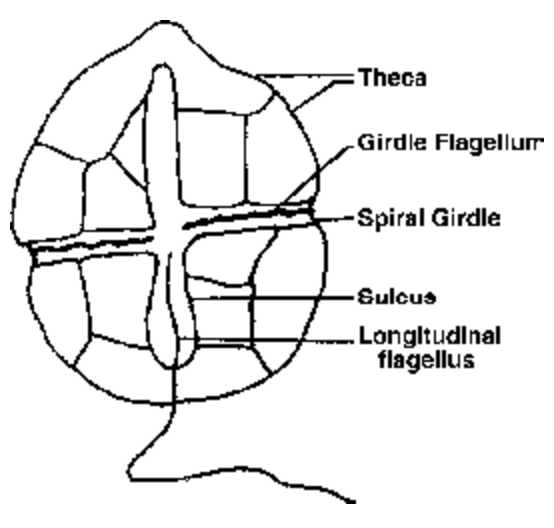
- The two flagella are different (heterokont), one transverse flagellum and other longitudinal flagellum. Due to presence of two flagella at right angles to each other, the dinoflagellates show peculiar spinning movement. Hence they are called whorling whips.
- Food reserve is stored in the form of starch in fresh water forms and oils in marine forms.
- A noncontractile vacuole called pusule is present near the flagellar base.
- Varieties of eye spots occur in dinoflagellates.
- Some marine dinoflgellates show bioluminescence, i.e., they emit light, e.g., Gonyaulax, Noctiluca, Pyrocystis, Pyrodinium, etc.
- Some dinoflagellates (e.g., Gonyaulax catenella) are poisonous to vertebrates. When they are in large number, they produce the toxin called saxitoxin.
- Asexual reproduction occurs by cell division, spores and cysts.
- Sexual reproduction is isogamous and anisogamous.
- The life cycle involves zygotic meiosis. Gametic meiosis occurs in Noctiluca.
Diatoms (Gk. dia - through, temnein - to cut)
Diatoms comprise the phylum Chrysophyta of algae. They constitute the class Bacillariophyceae. Bacillariophyceae contains about 200 genera and 5000 species (Bold et al. 1987). The important characters of Diatoms are:
- Diatoms are microscopic, variously coloured and of diverse forms which do not possess flagella except in the reproductive state.
- Diatoms occur in all aquatic and moist terrestrial habitats. They may be free floating or bottom dwellers.
- Diatoms may show gliding type of movement with the help of mucilage.
- The body is covered by a transparent siliceous shell known as frustule. The frustule is made of two valves, epitheca and hypotheca.
- Each cell has a large central vacuole. The single large nucleus is commonly suspended in the central vacuole by means of cytoplasmic strands.
- Photosynthetic pigments contain chlorophyll-a, chlorophyll-c, -carotene, fucoxanthin, diatoxanthin, diadinoxanthin, etc.
- The food reserve is in the form of oils and leucosin or chrysolaminarin (polysaccharide, b-1, 3 glucan), Volutin globules (proteinaceous in nature) are also present.
The common mode of multiplication is by binary fission. Each daughter retains one valve of the parent as epitheca and secretes a new hypotheca. As a result, one of the two daughters is slightly smaller than the parent. Over the generations there would be considerable reduction in size. The normal size is restored by the formation of rejuvenescent cells (auxospores).
- Sexual reproduction varies from isogamy to oogamy. Meiosis is gametic.
- Diatoms are unusual in that their vegetative cells are typically diploid.
- Diatoms resemble dinoflagellates in having fucoxanthin.
- Diatoms are very important photosynthesisers. A 60 tonne blue whale may have 2 tonnes of plankton in the gut which is mostly diatoms.
- The siliceous frustules of diatoms do not decay easily. They pile up at the bottom of water reservoirs and form big heaps called diatomite or diatomaceous earth.
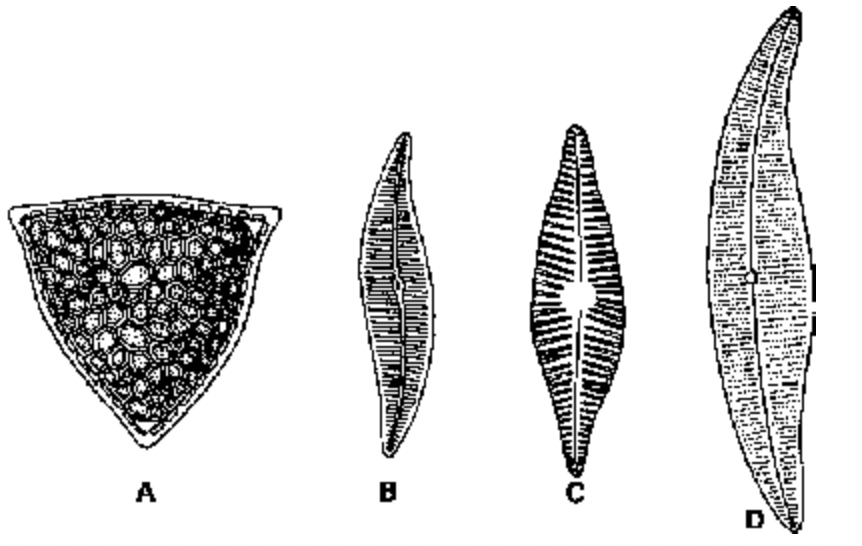
Fig. Some common diatoms. A. Triceratium; B. Pleurosigma; C. Navicula; D. Cymbella
Euglenoid flagellates (Euglena like flagellates)
Euglenoids are group of both chlorophyllous and non chlorophyllous flagellate protists. They belong to class Euglenophyceae and phylum or division Euglenophyta. Euglenoids include about 36 genera and 800 species. The important characteristics are:
- Euglenoids are unicellular flagellate protists of fresh water and damp soils.
- These protists are devoid of cellulose cell wall.
- The body is covered by thin and flexible pellicle (periplast). The pellicle has oblique but parallel stripes called myonemes.
- The euglenoids have two flagella, usually one short.
- They can also perform creeping movements by expansion and contraction of their body. The phenomenon is called metaboly.
- The apical end bears an invagination having three parts-cytostome, cytopharynx and reservoir.
- An orange-red eye spot or stigma contains red pigment astaxanthin, found elsewhere only in crustacea.
- Nutrition is mixotrophic (holophytic + saprobic).
-
Photosynthetic pigments are chlorophyll-a, chlorophyll-b,
 -carotene and xanthophylls.
-carotene and xanthophylls. - They store their carbohydrates as paramylum bodies.
- Under favourable conditions, they multiply by longitudinal binary fission.
- Sexual reproduction has not yet been definitely proved.
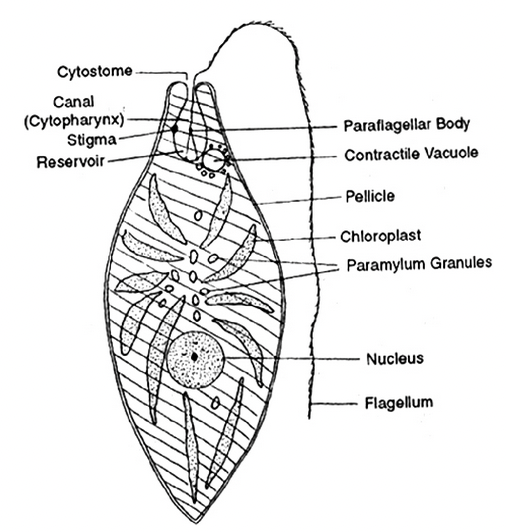
Consumer-decomposer Protists : Slime Moulds
They were formerly included amongst mycetozoa or fungus animals (de Bary 1887) or myxomycota (Mac Bride 1897). Slime moulds are included in the division of Gymnomycota by mycologists. Because of their protistan nature, they are also called protistan fungi. They have about 600 species. The slime moulds have the following characters:
- The slime moulds live usually amongst decaying vegetation.
- They do not have chlorophyll.
- They are surrounded by the plasma membrane only (somatic parts are without cell walls). However, the spores have the cellulose cell walls.
- At one stage of the life cycle they have amoeboid structure.
- They have phagotrophic or saprotrophic nutrition.
- Both asexual and sexual modes of reproduction are found. They produce spore within sporangia.
- Asexual reproduction takes place through binary fission, plasmotomy, spores, cyst and sclerotium.
- A spore possesses a cell wall of cellulose.
- The slime moulds resemble both protozoa and the true fungi. They are like protozoa in their amoeboid plasmodial stage and similar to true fungi in spore formation.
- Slime moulds are of two types: acellular and cellular.
Acellular Slime Moulds (Plasmodial Slime Moulds)
Acellular slime moulds exhibit the following characters:
- The spores germinate to produce biflagellate swarmer cells that function as gametes.
- The sexual reproduction is isogamous.
- The diploid zygote forms the plasmodium that becomes multinucleate by repeated mitotic division. Thus their somatic bodies are free living multinucleate, naked diploid protoplasmic masses called the plasmodia.
- The plasmodium forms a number of sporangia (fruiting bodies). Each sporangium is present on a stalk.
- The sporangium usually contains a network of fine threads called capillitium.
- The spores are formed by meiosis from the diploid protoplast or the sporangium.
- They move with the help of pseudopodia like the Amoeba.
Examples : Physarum, Physarella, Fuligo, Dictydium, etc.
Cellular Slime Moulds
Cellular slime moulds have the following characters:
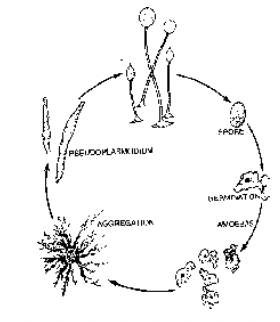
- Complete absence of flagellated cells in their life cycle.
- Presence of wall less uninucleate myxamoebae.
- Formation of pseudoplasmodium.
- Presence of naked sporangia (without sporangial cover).
- Presence of cellulose wall around spores.
- Anisogamous sexual reproduction, etc.
Examples : Dictyostelium, Polysphondylium, etc.
- Points to RememberFig. Life cycle of cellular slime mould
- A colourless Dinoflagellate, Blastodinium, is parasite on animals.
- Fire algae produce protein luciferin during bioluminiscnce.
- Noctiluca is a colourless dinoflagellate of coastal areas where bioluminescence was recorded for the first time.
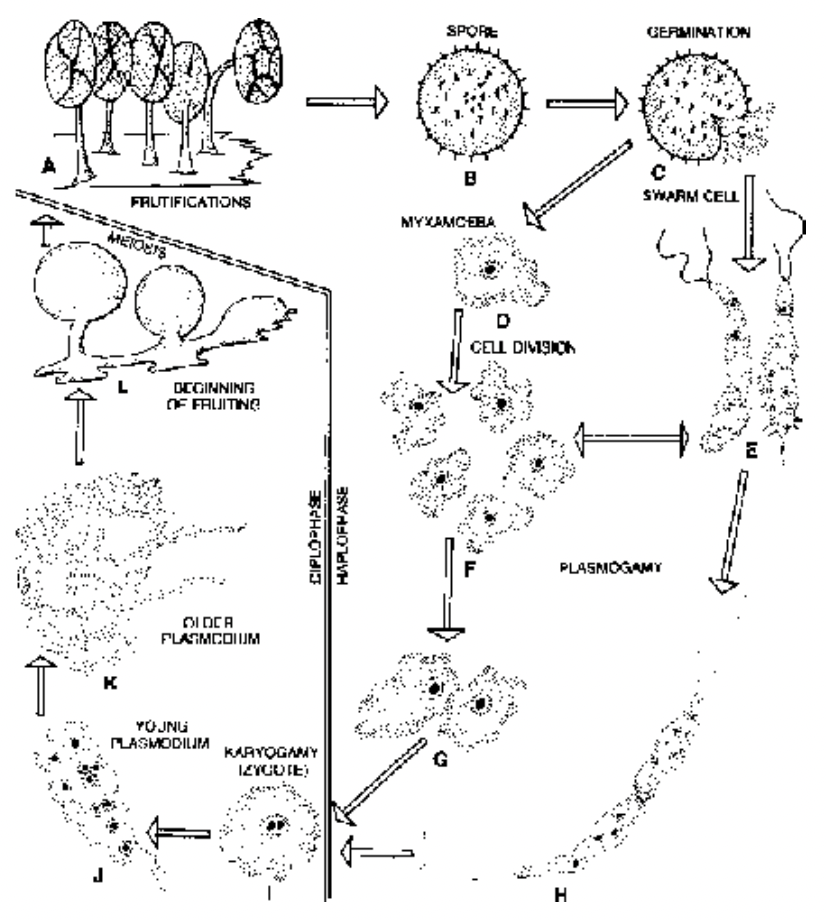
Fig. Life Cycle of Myxomycetes (acellular slime mold)
- The most common euglenoid is Euglena viridis (the spindle organism) which is most readily available for laboratory observations.
- Slime moulds are so called because they occur in the form of slimy mass during the vegetative phase.
- The protoplasm of plasmodium, a multinucleate somatic body of acellular slime mould is considered as purest in the living world.
- Slime moulds have characters of plants (cellulosic cell wall in spores), animals (phagotrophic nutrition) and fungi (spore formation).
- Cellular slime moulds are called communal slime moulds due to formation of pseudoplasmodium by coming together of numerous myxamoebae.
- Capillitium is sterile thread in sporangia of acellular slime moulds for dispersal of spores.
- Phaneroplasmodium is wall less multinucleate protoplasm of acellular slime moulds having branched veins with cyclosis.
- Zooxanthellae are dinoflagellate symbionts in other protists and invertebrates.
- Sexual reproduction has not been proved to occur in euglenoids.
- Photosynthetic protists fix about 80% of CO2 in the biosphere.
- Introduction
- Kingdom : Monera
- Reproduction
- Importance Of Bacteria
- Methanogens
- Viruses(Biological Classification)
- Reproduction And Transmission In Viruses
- Kingdom : Protista
- Major Groups Of Protista
- Kingdom : Fungi
- Sexual Reproduction
- Characteristic Feature Of Major Groups
- Mycorrhiza
- Exercise 1
- Exercise 2
- Exercise 3
- Exercise 4
- Exercise 5
- Exercise 6
- Exercise 7
- Exercise 8









